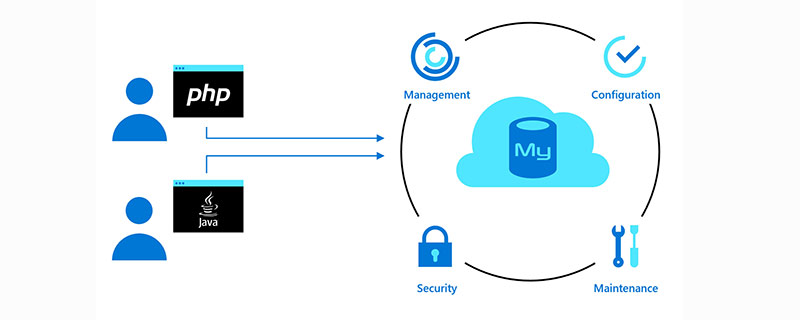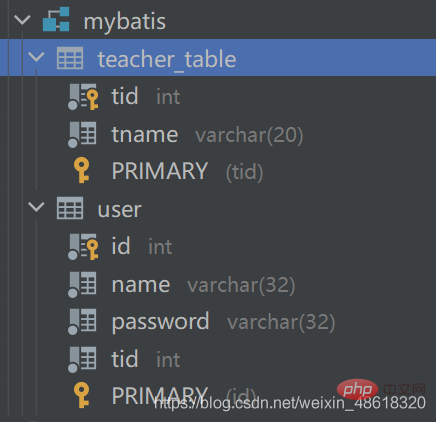Heim >Datenbank >MySQL-Tutorial >Verstehen Sie die Grundlagen von Mybatis
Verstehen Sie die Grundlagen von Mybatis
- coldplay.xixinach vorne
- 2021-01-22 09:29:551980Durchsuche

Empfohlenes kostenloses Lernen: MySQL-Video-Tutorial
mybatis
mybatis-config.xml detaillierte Konfiguration (löschen Sie beim Konfigurieren die redundanten Attribute und kein Chinesisch, sonst wird ein Fehler angezeigt gemeldet!)
<?xml version="1.0" encoding="UTF-8" ?>nbsp;configuration
PUBLIC "-//mybatis.org//DTD Config 3.0//EN"
"http://mybatis.org/dtd/mybatis-3-config.dtd"><!--configuration核心配置 配置文件的根元素 --><configuration>
<!-- 属性:定义配置外在化 -->
<properties></properties>
<!-- 设置:定义mybatis的一些全局性设置 -->
<settings>
<!-- 具体的参数名和参数值 -->
<setting></setting>
</settings>
<!-- 类型名称:为一些类定义别名 -->
<typealiases>
<!-- 实体类少 建议 第一种取别名方式-->
<typealias></typealias>
<!--实体类多 建议 第二种取别名方式
默认情况下用这种方式 别名为类名 首字母最好小写
-->
<package></package>
</typealiases>
<!-- 类型处理器:定义Java类型与数据库中的数据类型之间的转换关系 -->
<typehandlers></typehandlers>
<!-- 对象工厂 -->
<objectfactory></objectfactory>
<!-- 插件:mybatis的插件,插件可以修改mybatis的内部运行规则 -->
<plugins>
<plugin></plugin>
</plugins>
<!-- 环境:配置mybatis的环境 -->
<environments>
<!-- 环境变量:可以配置多个环境变量,比如使用多数据源时,就需要配置多个环境变量 -->
<environment>
<!-- 事务管理器 -->
<transactionmanager></transactionmanager>
<!-- 数据源 配置连接我的数据库-->
<datasource>
<property></property>
<property></property>
<property></property>
<property></property>
</datasource>
</environment>
</environments>
<!-- 数据库厂商标识 -->
<databaseidprovider></databaseidprovider>
<!-- 映射器:指定映射文件或者映射类 -->
<mappers>
<mapper></mapper>
</mappers></configuration>
Paging
Datenzugriff reduzieren
limt implementiert Paging
SQL-Anweisung: select * from table name limt 0,5;
- 0: Die Startposition der Daten
- 5: Die Länge von die Daten. Eins: Mybatis verwenden. 1 Schnittstelle 1.Schnittstelle
2. Implementieren Sie die Schnittstelle List<user> getUserByLimit(Map<string> map);</string></user>
3. Test:
<select>
select *
from mybatis.user
limit ${starIndex},${pageSize} </select>
Die dritte Methode: Verwenden Sie das Paging-Plug-in pageHeIper
SQL-Viele-zu-Eins-Verarbeitung
Datenbank:
<resultmap> <result></result> </resultmap>Die Benutzertabelle in der Datenbank entspricht der Entitätsklasse Student
@Test
public void getUserByLimitTest() {
SqlSession sqlSession = MyBatisUtils.getSqlSession ();
UserMapper mapper = sqlSession.getMapper (UserMapper.class);
HashMap hashMap = new HashMap<string> ();
hashMap.put ("starIndex", 1);
hashMap.put ("pageSize", 2);
List userByLimit = mapper.getUserByLimit (hashMap);
for (Object o : userByLimit) {
System.out.println (o);
}
sqlSession.close ();
}</string>
1. Interface

<select> select * from mybatis.user </select>2.xml Konfigurationsimplementierungsschnittstelle
/**
* 测试使用RowBounds实现分页
*/@Test
public void getUserByLimitRowBoundsTest() {
SqlSession sqlSession = MyBatisUtils.getSqlSession ();
RowBounds rowBounds = new RowBounds (0, 2);
List<user> userList = sqlSession.selectList ("com.kuang.w.dao.UserMapper.getUserList", null, rowBounds);
for (User user : userList) {
System.out.println (user);
}
//关闭
sqlSession.close ();
}</user>
package com.kuang.w.pojo;
import lombok.Data;
/**
* @author W
*/
@Data
public class Teacher {
private int tId;
private String tName;
}
mybatis-config.xm-Konfigurationpackage com.kuang.w.pojo;import lombok.Data;/**
* @author W
*/@Datapublic class Student {
private int id;
private int tid;
private String name;
private String password;
private Teacher teacher;}3 Test
List<student> getStudentList();</student>

SQL-Eins-zu-viele-Verarbeitung
Die der Datentabellenstruktur entsprechende Entitätsklasse bleibt unverändert
Der erste Weg: Gemeinsame Abfrage mit mehreren Tabellen
1 Schnittstelle <!-- 多对一查询
1 子查询 mysql 通过一个表里是数据 与另一个表的一个数据相的情况下 查询另一个的数据 一起显示
-->
<select>
select *
from mybatis.user; </select>
<resultmap>
<!-- 复杂属性 对象用 :association 集合用:collection-->
<!--column 数据库中的字段 property 实体类中的属性-->
<result></result>
<result></result>
<result></result>
<!--javaType 一个 Java 类的全限定名
,或一个类型别名(关于内置的类型别名,可以参考上面的表格)。
如果你映射到一个 JavaBean,MyBatis 通常可以推断类型。
然而,如果你映射到的是 HashMap,
那么你应该明确地指定 javaType 来保证行为与期望的相一致。-->
<association></association>
</resultmap>
<select>
select *
from mybatis.teacher_table
where tid = #{id}; </select>2.1 XML-Implementierungsschnittstelle
<!--2 多表联查--> <select> select u.id uid, u.name uname, u.password upassword, u.tid utid, t.tname from mybatis.user u, mybatis.teacher_table t where t.tid = u.tid; </select> <!-- 映射--> <resultmap> <result></result> <result></result> <result></result> <result></result> <association> <result></result> </association> </resultmap>2.2 Zuordnungskonfiguration
<?xml version="1.0" encoding="UTF8" ?>nbsp;configuration
PUBLIC "-//mybatis.org//DTD Config 3.0//EN"
"http://mybatis.org/dtd/mybatis-3-config.dtd"><configuration>
<properties></properties>
<settings>
<setting></setting>
</settings>
<typealiases>
<typealias></typealias>
<typealias></typealias>
</typealiases>
<environments>
<environment>
<transactionmanager></transactionmanager>
<datasource>
<property></property>
<property></property>
<property></property>
<property></property>
</datasource>
</environment>
</environments>
<mappers>
<!-- <mapper resource="com/kuang/w/dao/TeacherMapper.xml"></mapper>
<mapper resource="com/kuang/w/dao/StudentMapper.xml"></mapper>-->
<mapper></mapper>
<mapper></mapper>
</mappers></configuration>3 Test
@Test
public void getStudentListTest() {
SqlSession sqlSession = MyBatisUtils.getSqlSession ();
StudentMapper mapper = sqlSession.getMapper (StudentMapper.class);
List<student> studentList = mapper.getStudentList ();
for (Student student : studentList) {
System.out.println (student);
}
sqlSession.commit ();
sqlSession.close ();
}</student>
ErgebnisList<teacher> getTeacher(int tid);</teacher>Zweiter Weg: Unterabfrage
1 Schnittstelle <select>
select t.tid, t.tname, u.id, u.name, u.password
from mybatis.user u,
mybatis.teacher_table t
where t.tid = u.tid
and t.tid = #{tid}; </select> 2 Schnittstelle implementieren
<resultmap> <result></result> <result></result> <!-- 复杂属性 对象用 :association 集合用:collection--> <collection> <!--javaType 指定属性类型 一个 Java 类的全限定名--> <result></result> <result></result> <result></result> <result></result> </collection> </resultmap>
3 Testen Sie wie oben
. . . .
Verwandte kostenlose Lernempfehlungen:
MySQL-Datenbank(Video)
Das obige ist der detaillierte Inhalt vonVerstehen Sie die Grundlagen von Mybatis. Für weitere Informationen folgen Sie bitte anderen verwandten Artikeln auf der PHP chinesischen Website!

